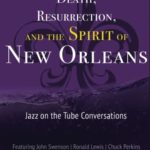“Basin Street Blues” – Louis Armstrong and his Hot Five (1928)
The barbershop quartet starts at 1:20
Louis Armstrong (voice and cornet), Jimmy Strong (clarinet), Fred Robinson (trombone), Mancy Cara, (banjo), Earl Hines (celeste and piano), Zutty Singleton (drum
At the 1:20 mark Hines stops playing the piano and leads the singing that supports Armstrong’s vocal solo, a role Armstrong was thoroughly familiar with going back to his childhood as a street singer.
Note that when the band comes back in after a short piano break by Hines, the piano drops out again and the “barbershop” harmonies come back (at 2:20) to support Armstrong’s cornet solo.
This was the “zone” where Armstrong was most comfortable throughout his career and all his artistry was rooted in it.
Before he mastered the horn, Armstrong sang lead (the improvising part) in a vocal quartet. He always considered his singing to be his primary art.
“Singing was into my blood more than the trumpet… I had one of the finest All Boys Quartets that ever walked the streets of New Orleans.” – Louis Armstrong.
Critics who think Armstrong’s singing was something added on later in his career as a sort of show biz pandering are just plain ignorant and have no ears.
Earl Hines, raised in Pittsburgh, was also thoroughly familiar with the Afro-American vocal art now known as “barbershop quartet” music. In fact, he was a trained barber.
See if you can hear the “barbershop” in the accompanying chords in this improvised piece by him:
“I don’t think I think when I play. I have a photographic memory for chords, and when I’m playing, the right chords appear in my mind like photographs long before I get to them.” – Earl Hines
There is a theory that the unique harmonies of American music derive from Liszt’s “Liebstraum” no. III, a composition published in 1850.
Presumably, these classical European composers were familiar with the Liszt piece yet not none of them referred to Liszt-influenced jazz harmony when talking about their American-inspired works.
That’s because they were not responding to Liszt-via-America harmony. They were responding to a unique harmonic system developed in North America by people of African (and possibly Native American) ancestry.
“Harmony” is not a monolithic thing”
Europe, the presumed birthplace of harmony (and that’s debatable), gave birth to many, many different harmonic systems.
For example, no one would confuse the music of Medieval times, the Renaissance, Monteverdi, Bach and Debussy. They are radically different and that difference comes from the harmonic system they’re using, each one a creation of a specific time and place (and in some cases a person.)
So when talking about “harmony,” it’s probably best to define where, when and whose harmonic system you’re talking about.
With this in mind, rather than say “jazz was created from European harmony and African rhythm”, it’s far more accurate to say that like many people before them, African-Americans devised their own harmonic system, informed perhaps by “European harmony”, but not from Europe.
(By the way, the “African” origins of jazz rhythm is also highly debatable, but that’s an article for another time.)
Here’s the kind of music European composers were responding to when they wrote their American-flavored pieces: inspired lyrical improvisation over syncopated barbershop harmonies.
Louis Armstrong plays “Star Dust” (1931)
The following film was made possibly in the 1940s and unfortunately I have no information about it. It’s a Hollywood version of how a typical “barbershop” group might perform.
I put it up to illustrates three things:
1. This is not a specialized, esoteric form of music just for barbershops or barbershop competitions. It’s how people commonly made and heard music in the pre-Internet, pre-TV, pre-radio, pre-record days.
2. Each part has a specific role to play and the straw hat singer plays the role Armstrong assumed in his own “All Boys Quartet” and with Joe Oliver, elaborating on the melody sung “straight” by a different part.
3. Vocal music and impressions of instruments (or makeshift ones) were probably exponentially more common that groups with actual instruments, especially in the early years of the music
Click here to visit Vic Hobson’s website.
Bonus: Lester Bowie’s Brass Fantasy – “I Only Have Eyes for You”
Another trumpet master who feels the great Afro-American vocal tradition
– Ken McCarthy
Jazz on the Tube
P.S. Our unique programming is made possible by help from people like you. Learn how you can contribute to our efforts here: Support Jazz on the Tube
Thanks.






